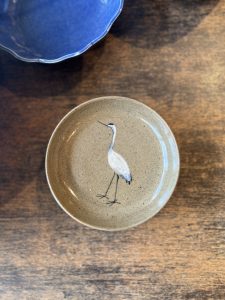「鳥」との付き合いは近くて長い(愛知県名古屋市千種区姫池通 骨董買取 古美術風光舎)
2025.08.27
そういえば、「鳥」をモチーフにした美術品や日用品は本当に多いような気がします。先日自分が買ったハンカチにも実は鳥のモチーフが入っていたりと、思い返してみてほしいのですが、どこかしら鳥のモチーフがあることに気が付きます。

歴史的な建造物や美術館などで鑑賞する作品においても、鳥の作品が世代や国を問わずあるような気がします。そしてなぜがその存在の意味も、世代、国問わず同じ解釈に近いような気もします。その翼と共に自由と解放感の願望なのか、 優雅な舞い、鮮やかな羽の色、澄んだ鳴き声など自然界の美しさの象徴なのか、神聖な存在としての象徴なのか、憧れる要素がどの時代や国の人間にも同じように映るのでしょうね。
日本においは「花鳥風月」という自然の美しい景色や事物を愛でる風流な心を表す言葉がありますが、「鳥」は単なる景色の一部ではなく、昔から特別な意味や感情を与えてくれる存在がその言葉からわかります。たとえば有名な作品ですと、丸山応挙の「孔雀図」、伊藤若冲の「群系図」、正倉院の「鳥毛篆書屏風」はたまた、キトラ古墳の「朱雀」ではないですが、どの鳥にもそれはそれは優雅に美しく、そして神聖な雰囲気が伝ってきます。また、日本「八咫烏」や、エジプトの遺跡のハヤブサの姿をしたホルス神に遡ると、古の人類の歴史は鳥と共に紡いでいるような感じもしますよね。話が大きくなってきたぞ…。
ところで、なぜ急に「鳥」なんだ?とお思いでしょう笑。
先日なんですが仲間内と話していたのですが、野鳥ことに海鳥が大好きな方が「思い切って海外のウミネコをウォッチするツアーに行ってくるわ。」というなんとも羨ましい話を耳にしまして。そんななかなか体験することのできなことにチャレンジする姿勢にもいろいろ羨ましいかぎりなのですが、話の流れで「実は鳥って賢いよね」って話にもなったわけです。
そういえば最近、店先のゴミを荒らしていたカラスもそうですが、ここは「ゴミ(えさ)が出るぞ」とすぐ理解し、しばらくゴミ捨て場がロックオンされたいたり、知り合いのオカメインコちゃんはもちろん歌うし喋るし、肩に乗って自分かわいいアピールもしてきたりとなかななの芸達者らしくて、確かに鳥の賢さは驚くべきものがあります。
動画でもよくみるのですが、鳥の中には上手に道具を使ったり、複雑な問題を解決したり、鏡に映った自分を認識したり、さらに将来の出来事を計画する能力を持っている種も。先日のゴミ荒らしのカラスはないですが、カラスは特に賢いことで知られていて、石を水の中に入れて水位を上げたり、飲み物に届くようにする「イソップ物語」のような行動を実際に行うことがわかっています。また、オウムやインコは人間の言葉を真似るだけでなく、言葉の意味を理解し、状況に応じて使い分けることができることもできたりと、私たちが考える以上に多様で知性も持ち合わせてるんじゃないかと思います。
脳の構造上の分析でもそれはわかっているようでして、鳥の脳は全体的なサイズは小さいものの、神経細胞(ニューロン)が非常に高い密度で詰まっており、特にカラスやオウムなどの賢い鳥ではこの神経細胞の密度が一部の霊長類よりも高いことが分かっています。この高密度な神経細胞の配置によって、効率的な情報処理が可能になっていると考えられているようです。また、鳥の脳には哺乳類の大脳新皮質に相当する機能を持つ「パリウム」という部位があり、このパリウムが、複雑な思考や学習、記憶を司っていることが研究で明らかになっております。
また多くの賢い鳥は厳しい環境で生き抜くために、高度な認知能力を進化させて、餌をとるために道具を使ったり、食べ物を隠し後で取り出すためにその場所を正確に記憶したり、腐敗する速度を予測し早く傷むものから消費する行動も確認されています。群れで生活し、協力して問題を解決したりと社会性も持ち合わせていたり、また、他の個体から学習したり人間や一部の賢い哺乳類と同様に、カラスなどの賢い鳥は長い子育て期間によって学習や認知能力の発達にとって重要な「投資」であると考えられる知恵も備わっているようでして、その脳のおかげで能力を存分に発揮しています。
小さな見た目に反してそんな脳の構造や知能を持ち合わせていることを知ると、これまでの人類の憧れや神のような存在にそりゃなるわけですが、なんといっても鳥と人間の大きな違いは大体の鳥は「飛べる」こと。
人類700万年の歴史において飛ぶことが可能になったのはたかだが100年ちょっと前ですから、飛ぶことのできない人間が、700万年もの間、「鳥にはかなわんな…」などと空を自由に飛ぶ鳥を眺めては気持ちを乗せていたことでしょうね。
そして、この手にあるハンカチの鳥を眺めながらここまで人間に寄り添った鳥に700万年もの妄想が暴走するのでありますが、これまでもこれからも「鳥」との近くて長い付き合いは続きそうです。
それではごきげんよう。(スタッフY)
I feel like there are so many artworks and everyday items with bird motifs. If you think about it, even the handkerchief I recently bought has a bird design on it, and you start to notice bird motifs everywhere.
I also feel that works featuring birds exist across generations and countries, whether in historical buildings or museums. For some reason, the meaning of their existence seems to be interpreted similarly, regardless of era or nationality. Perhaps it’s the desire for freedom and liberation with their wings, or the symbol of nature’s beauty with their elegant flight, vibrant colors, and clear songs, or a symbol of a sacred being—the elements of admiration must appear the same to people in any age or country.
In Japan, we have the phrase “Kachou Fuugetsu,” which expresses the elegant heart that appreciates the beautiful scenery and elements of nature. From this phrase, we can see that birds are not just a part of the scenery but have long been a special presence that gives us meaning and emotion. For example, famous works like Maruyama Okyo’s “Peacocks” (Kujaku-zu), Ito Jakuchu’s “Rooster and Hen” (Gunkei-zu), the Shosoin’s “Screen with Inscribed Feather Script” (Torige Tensho Byobu), or even the “Suzaku” (Vermilion Bird) from the Kitora Tomb, all convey an elegant, beautiful, and sacred atmosphere. And when we trace back to Japan’s “Yatagarasu” (a three-legged crow in Japanese mythology) or the falcon-headed Horus from Egyptian ruins, it feels as if the history of ancient humanity was woven together with birds. This is getting to be a big topic…
By the way, you might be wondering why I suddenly brought up “birds,” haha.
The other day, I was talking with some friends, and I heard an incredibly enviable story from a friend who loves wild birds, especially seabirds. They said, “I’m just going to go on a tour to watch black-tailed gulls overseas.” The courage to take on such a rare experience is quite enviable, but in the flow of conversation, we ended up talking about how intelligent birds actually are.
Speaking of which, a crow was rummaging through the trash at a shop front recently. It quickly understood that this was a spot where “trash (food) comes out” and kept its eye on the garbage area for a while. Also, my friend’s cockatiel can sing and talk, and it gets on their shoulder to show off how cute it is, so it’s quite a talented performer. The intelligence of birds is truly astonishing.
I’ve often seen videos of some bird species that can skillfully use tools, solve complex problems, recognize themselves in a mirror, and even plan for future events. It’s not the same as the crow from the other day, but crows are especially known for their intelligence. They’ve been observed performing actions straight out of an Aesop’s fable, like putting stones into water to raise the water level and reach a drink. Also, parrots and parakeets can not only mimic human speech but also understand the meaning of words and use them appropriately depending on the situation. I think they possess a diversity and intellect far beyond what we might imagine.
This is also known from analyses of their brain structure. Although the overall size of a bird’s brain is small, its nerve cells (neurons) are packed in at a very high density. It’s been found that this density is even higher in some intelligent birds like crows and parrots than in some primates. It’s thought that this high-density arrangement of neurons allows for efficient information processing. Furthermore, a part of the bird’s brain called the “pallium” has functions equivalent to the mammalian neocortex, and research has revealed that this pallium is responsible for complex thinking, learning, and memory.
Many intelligent birds have also evolved advanced cognitive abilities to survive in harsh environments. They use tools to get food, accurately remember where they hid food to retrieve it later, and even predict the rate of decay to consume items that will spoil faster first. They also have social skills, living in flocks and cooperating to solve problems and learn from other individuals. Just like humans and some intelligent mammals, smart birds like crows invest a long period of time in raising their young, which is considered crucial for the development of their learning and cognitive abilities. Thanks to this brain, they can fully demonstrate their skills.
When you learn that they possess such brain structures and intelligence despite their small appearance, it’s no wonder they became objects of human admiration and were seen as divine beings. But the biggest difference between birds and humans is that most birds can “fly.”
Since humanity’s 7-million-year history, flying has only been possible for a little over a century. Humans, who couldn’t fly, must have spent 7 million years gazing at birds flying freely in the sky, wishing they could join them. And as I gaze at the bird on this handkerchief, my mind goes wild with 7 million years of fantasies about these creatures who have been so close to humanity. Our close and long relationship with “birds” will continue, now and forever.
With my best wishes. (Staff Y)

